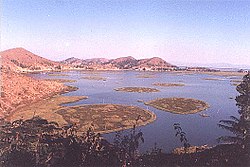Loktak Lake
| Loktak Lake | |
|---|---|

View of Loktak Lake and Phumdis
|
|
| Location | Manipur |
| Coordinates | 24°33′N 93°47′E / 24.550°N 93.783°ECoordinates: 24°33′N 93°47′E / 24.550°N 93.783°E |
| Type | Fresh water (lentic) |
| Primary inflows | Manipur river and many small rivulets |
| Primary outflows | Through barrage for hydropower generation, irrigation, and water supply |
| Catchment area | 980 km2 (380 sq mi) |
| Basin countries | India |
| Max. length | 35 km (22 mi) |
| Max. width | 13 km (8 mi) |
| Surface area | 287 km2 (111 sq mi) |
| Average depth | 2.7 m (8.9 ft) |
| Max. depth | 4.6 m (15.1 ft) |
| Surface elevation | 768.5 m (2,521 ft) |
| Islands | Thanga, Ithing, Sendra islands. Also many floating islands called phumdis or phumshongs |
| Settlements | Imphal & Moirang |
| Designated | 19 August 2002 |
Loktak Lake is the largest freshwater lake in Northeast India, and is famous for the phumdis (heterogeneous mass of vegetation, soil, and organic matter at various stages of decomposition) floating over it. Keibul Lamjao is the only floating national park in the world. It is located near Moirang in Manipur state, India. The etymology of Loktak is Lok = "stream" and tak = "the end". The largest of all the phumdis covers an area of 40 km2 (15 sq mi) and is situated on the southeastern shore of the lake.
The Keibul Lamjao National Park is the last natural refuge of the endangered sangai (state animal)Rucervus eldii eldii or Manipur brown-antlered deer (Cervus eldi eldi), one of three subspecies of Eld's deer.
This ancient lake plays an important role in the economy of Manipur. It serves as a source of water for hydropower generation, irrigation and drinking water supply. The lake is also a source of livelihood for the rural fishermen who live in the surrounding areas and on phumdis, also known as “phumshongs”. Human activity has led to severe pressure on the lake ecosystem. 55 rural and urban hamlets around the lake have a population of about 100,000 people. Considering the ecological status and its biodiversity values, the lake was initially designated as a wetland of international importance under the Ramsar Convention on 23 March 1990. It was also listed under the Montreux Record on 16 June 1993, "a record of Ramsar sites where changes in ecological character have occurred, are occurring or are likely to occur".
Of the two river systems which drain the Manipur state—the Barak River and the Manipur River—the Manipur River flows through the Manipur Valley. The river rises in the north at Karong, flows south of Imphal and hence is also known as the Imphal River. Along its course through the valley downstream of Imphal, the bed slope of the river is gentle. The Drainage pattern is sub-dendritic, sub-parallel and sub-radial, dictated by the structure and lithology of the area. Imphal, Iril and Thoubal River valleys also exhibit a meandering river course.
...
Wikipedia
